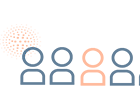Romano, A. A., Allanson, J. E., Dahlgren, J., Gelb, B. D., Hall, B., Pierpont, M. E., Roberts, A. E., Robinson, W., Takemoto, C. M., & Noonan, J. A. (2010). Noonan syndrome: clinical features, diagnosis, and management guidelines. Pediatrics, 126(4), 746–759. https://doi.org/10.1542/peds.2009-3207
Turner, A. (2011). Noonan syndrome. Journal Of Paediatrics And Child Health, 50(10), E14-E20. doi: 10.1111/j.1440-1754.2010.01970.x
Cessans, C., Ehlinger, V., Arnaud, C., Yart, A., Capri, Y., & Barat, P. et al. (2016). Growth patterns of patients with Noonan syndrome: correlation with age and genotype. European Journal Of Endocrinology, 174(5), 641-650. doi: 10.1530/eje-15-0922
Turner A. M. (2014). Noonan syndrome. Journal of paediatrics and child health, 50(10), E14–E20. https://doi.org/10.1111/j.1440-1754.2010.01970.x
Allanson, J., Bohring, A., Dörr, H., Dufke, A., Gillessen-Kaesbach, G., & Horn, D. et al. (2010). The face of Noonan syndrome: Does phenotype predict genotype. American Journal Of Medical Genetics Part A, 152A(8), 1960-1966. doi: 10.1002/ajmg.a.33518
Liao, J., & Mehta, L. (2019). Molecular Genetics of Noonan Syndrome and RASopathies. Pediatric endocrinology reviews : PER, 16(Suppl 2), 435–446. https://doi.org/10.17458/per.vol16.2019.lm.molecularnoonan
Rauen K. A. (2013). The RASopathies. Annual review of genomics and human genetics, 14, 355–369. https://doi.org/10.1146/annurev-genom-091212-153523
Aoki, Y., Niihori, T., Inoue, S., & Matsubara, Y. (2016). Recent advances in RASopathies. Journal of human genetics, 61(1), 33–39. https://doi.org/10.1038/jhg.2015.114





